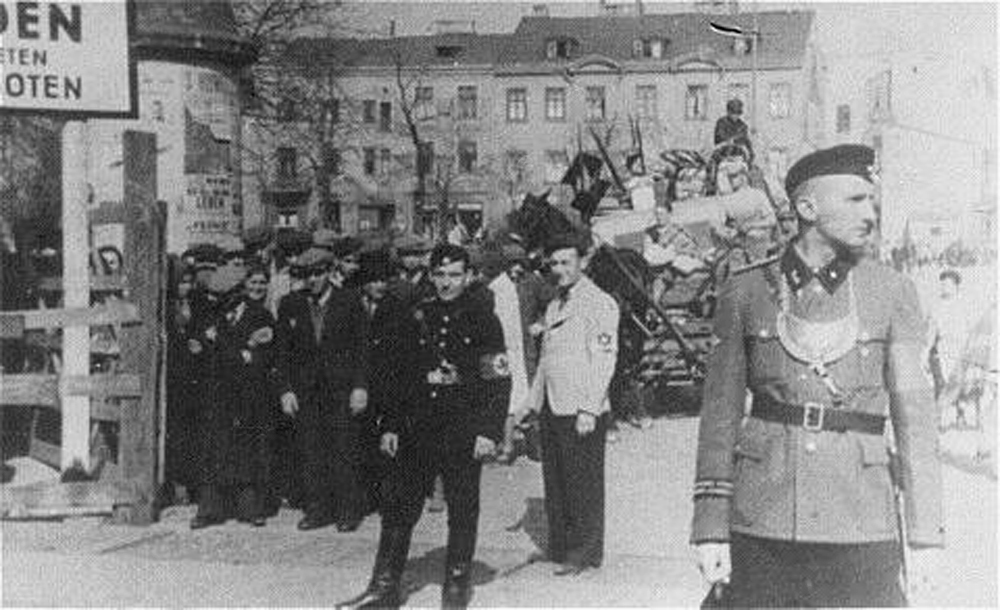Prelude – German policy in the first months of the occupation
After the German army entered Łódź, they started to harass the Jews immediately. They were put into degrading or meaningless works. Their catalogue was long: burying anti-aircraft ditches with their bare hands, scraping floors with nails, washing windows, floors or toilets with their own underwear, cleaning carpets with a toothbrush without bending their legs, cleaning toilets with their bare hands, flapping wipers with sticks on the back of another person, placing people in two ranks and forcing them to beat or spit on the person in front, forcing them to “dance” or sing in which the alleged guilt of the Jews was emphasized. In addition, Germans were burning synagogues, which crowned their ordinance to create a «Jewish quarter” in Łódź.
“Germanization” of the city
Jewish elites had learned about the creation of the ghetto a few days before the Germans signed the document on this matter. The ordinance from February 8, 1940, was prepared by the head of the police, Johannes Schäfer. It stated that the Jews of Łódź had to move to the 5th and 6th police districts in the northern part of the city including the Old Town and the poorest district Bałuty. The new decision of the German police was communicated to the Jewish community by the newspaper “Lodscher Zeitung”. The decision caused displacement on a large scale. Until February 29, the area of the delimited ghetto had to be abandoned both by Volksdeutsche and by Poles.
The creation of the ghetto was accompanied by decisions that were introduced in the former Łódź voivodship under the slogan of “Germanization” of this area. To humiliate Jews, from November 14, they had to wear special markings. In the Kalisz province, Friedrich Ubelhör obligated every Jew, regardless of age, to wear “Jewish-yellow” armbands. Failure to comply with the regulation resulted in the death penalty. One of the Jewish witnesses commented on the new German orders: “It is difficult to get used to this stigmatization (…). We were ordered to accept the external sign of national inferiority, the sign of a pariah. ” (…) We are returning to the Middle Ages ”.
The people displaced to the Lodz ghetto were allowed to take with them only one suitcase with clothes and underwear, as well as family souvenirs. It was forbidden to rent any wheeled vehicles in order to move – everyone had to go to the ghetto on foot. The exception was made for the bedridden patients.
The method of leaving the apartment was also described by separate regulations. It had to be locked and the keys handed over to the designated caretaker. To avoid crowds, the Germans first ordered 300 resettlements a day, then limiting it to 150. One of the resettled Jew recalled how his family left the apartment: “On Friday, February 16, 1940, at 1 p.m., two uniformed Germans and a civilian showed up. Without much ado, they ordered everyone to leave the apartment within ten minutes.”
Although it was not allowed to take any home furnishings, in practice many Jews decided to transport their belongings. It took a lot of effort. According to witnesses, such a move looked terrifying: “Younger children dragged overpacked sledges, and older children helped to carry or carried themselves individual pieces of furniture or their parts. The husband carried one part of the bed, the wife carried the other. The tailor carried the sewing machine, and other Jewish craftsmen took their tools, although it was forbidden to take their equipment with them”.
“Bloody Thursday”
During the resettlement, the Germans organized terrorist actions aimed at accelerating the concentration of Jews in the ghetto. The largest action was carried out on March 6 and on the following day. The German army and the police threw the remaining Jewish families out of the apartments at Piotrkowska Street. They were driven out into the streets, and all those who resisted or were unable to leave their homes were tortured and killed on the spot. One of the witnesses recalled: “The survivors were robbed of everything without leaving them even ten marks – which so far was common in requisitions and evacuations. Several children were killed that night. The bodies of the shot were lying in pools of blood in the rooms and in the yard”.
“Bloody Thursday” took many lives, although historians today disagree about the exact data. It is said about 200 or even 1500 murdered Jews.
The beginning of the end of Łódź Jews
These events caused a flow of Jewish people into the ghetto but they were unable to be accommodated. Therefore, its area was enlarged and at the same time marked with barbed wire. Along the borders, Germans placed the boards informing about the prohibition of entering the district designated for Jews.
On April 30, 1940, the mayor of the city, Franz Schiffer, sent a letter to Chaim Rumkowski, “chairman of the Jewish Eldership” making him responsible for observing the ban on leaving the ghetto by Jews and arranging the internal life of the closed district. In fact, it meant sealing the ghetto. From then on, no one could cross its borders without permission. Police president Schäfer also ordered in a special instruction of May 10, 1940, to shoot the Jews trying to leave the ghetto.
The Łódź ghetto operated until 1944, when the Jews were sent first to the death camp in Kulmhof (Chełmno on Ner), and then to Auschwitz-Birkenau. Until then, about 44,000 died in Łódź ghetto, mainly of disease and starvation.





